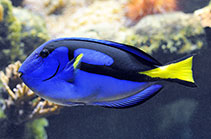| Family: |
Acanthuridae (Surgeonfishes, tangs, unicornfishes), subfamily: Acanthurinae |
| Max. size: |
31 cm TL (male/unsexed) |
| Environment: |
reef-associated; marine; depth range 2 - 40 m |
| Distribution: |
Indo-Pacific: East Africa, including the Mascarene Islands (Ref. 37792) to Kiribati, north to southern Japan, south to the southern Great Barrier Reef, New Caledonia, and Samoa. |
| Diagnosis: |
Dorsal spines (total): 9-9; Dorsal soft rays (total): 19-20; Anal spines: 3-3; Anal soft rays: 18-19. Description: Characterized further by having contrasting pattern of bright blue and black; black-edged yellow caudal fin; single retractable caudal spine on each side of caudal peduncle; greatest depth of body 2.1-2.4 in SL (Ref. 90102). |
| Biology: |
Occur in clear, current-swept terraces of seaward reefs. Observed in loose aggregations 1 or 2 meters above the bottom; juveniles and subadults typical in groups near isolated Pocillopora eydouxi coral heads and when alarmed hide themselves tightly among the branches (Ref. 9710). Benthopelagic (Ref. 58302). Feed on zooplankton and occasionally on algae (Ref. 9710, 48637, 27115, 83665). Relatively uncommon and highly localized (Ref. 1602, 9710). Very popular and hardy aquarium fish. Anterolateral glandular groove with venom gland (Ref. 57406). |
| IUCN Red List Status: |
Least Concern (LC); Date assessed: 07 May 2010 Ref. (130435)
|
| Threat to humans: |
venomous |
Source and more info: www.fishbase.org. For personal, classroom, and other internal use only. Not for publication.

